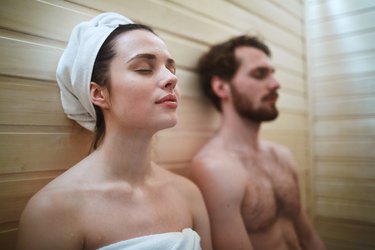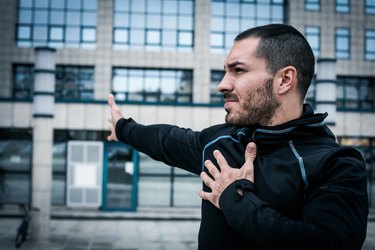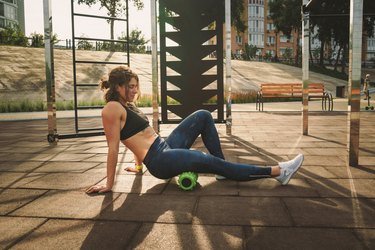

You decided to go big or go home during your last sweat session and now you're seriously hurting. So, to deal with sore muscles, you grab an ice pack, pop an Advil and you're good to go, right? Not so fast. It turns out, a lot of popular workout recovery methods aren't all they're cracked up to be.
Unless you're a pro athlete preparing for a competition, the majority of workout recovery tricks are just plain unnecessary — and in certain cases can even be detrimental.
Video of the Day
Video of the Day
"Although these strategies don't work from a physiological perspective, people still do them because many of them feel good," says Todd Buckingham, PhD, lead exercise physiologist for Mary Free Bed Sports Rehabilitation. "In addition, we want to do something and be an active participant in our recovery."
Still, you could be making things even worse or just wasting your money. Before you purchase that CBD cream, read this.
Related Reading
1. Ice
Hold on, icing reduces inflammation — and isn't that a good thing? Not for workout recovery. "Inflammation is caused by increased blood flow, which is part of the muscle healing process after exercise," Buckingham says.
Although applying ice might numb the discomfort, you're reducing your muscle's ability to fully repair and grow stronger.
"You'll inhibit improvement if you ice and will only reap about 80 percent of the benefits of exercise," he says. Translation: Diminished muscle growth and power.
The same goes for cryotherapy or an ice bath: Give these strategies the cold shoulder.
2. NSAIDs
Anti-inflammatory over-the-counter pain meds have a similar effect as ice. They reduce the number of chemicals that tell your body to sense pain.
"NSAIDs don't help you get better faster," Buckingham says. "I don't recommend them because you won't get as much muscle repair due to the reduced inflammation."
3. Sports Creams
Pain relief lotions contain ingredients like menthol or capsaicin that provide a cooling tingle. "The sensation is distracting, but it won't physiologically improve your muscle health," Buckingham says.
As for arnica, the health darling du jour? "The claim is that it may reduce swelling, but there is very little scientific evidence to support this," he says.
The same goes for CBD pain relief creams. "CBD is so new that we still don't know the true effects of it because we haven't had time to study it," he says. "But right now, there is no scientific evidence that it actually contributes to recovery from a physiological standpoint."
That said, these ointments aren't bad for you, so if the placebo effect is working for you, feel free to slather them on.
4. Epsom Salts
Can these little white crystals truly reduce swelling and pain post-workout? "The theory behind Epsom salt baths is that when the salts dissolve in the water that they can then get into your body through the skin," Buckingham says. "This has not been proven."
Still, it might have a soothing effect. "Just sitting in warm water can help relax your muscles and joints," he says. "The Epsom salts may have a scent to them that could help you relax further, but there is no physiological evidence that Epsom salts themselves speed recovery."
5. Compression Socks or Boots
Compression boots are inflatable "leg sleeves" that stretch from your foot all the way up to your hip. They contain four to five chambers that fill with compressed air and massage your tootsies, calves and hamstrings.
Compression socks are long stocking-like socks that are designed to squeeze your legs more than ordinary socks.
By squeezing your legs, they idea is that they help move blood from your legs back to your heart while also reducing any build-up of lymphatic fluid in the area, Buckingham says.
People believe this helps flush lactate (acid that builds up in the body after intense exercise and causes muscle pain and cramps) out of your system and reduce soreness. Unfortunately, that's not the case.
"Compression boots or socks won't help you recover any faster," he says. "Still, they also won't do any harm and might feel good."
According to the Cleveland Clinic, doctors might recommend compression socks for people who have health conditions related to circulation in their legs, such as venous insufficiency (when blood pools in your legs instead of being pumped back up to the heart) or to improve blood flow during long plane rides, both of which put you at greater risk of developing blood clots.
But the evidence is thin that it will help with exercise recovery.
6. Propping Your Legs Up the Wall
The claim: Stretching your toes skyward removes lactate and improves circulation by shunting blood to your heart.
The truth: "The best way to boost circulation and clear lactate from the muscle is movement, like by walking or jogging," Buckingham says. "Each time your muscles contract, this helps pump the blood through your venous system."
Then there's this: Assuming your leg muscles were under stress during exercise, they could actually use the extra blood flow to help with repair. The last thing you want to do is curtail their supply.
7. Saunas
You may have heard that sweating out toxins will speed up workout recovery. Vicious lies!
"Perspiration doesn't filter out toxins; your liver and kidneys do that," Buckingham says. "In fact, saunas and hot tubs might make you more dehydrated, which could negatively impact recovery."
A small December 2019 study in the International Journal of Sports Physiology and Performance found that spending time in a sauna after training led to performance declines and greater fatigue and discomfort in competitive swimmers.
Although full-body heat isn't a great idea, keep a heating pad on hand. "It can enhance blood flow to a sore area, loosen you up and improve mobility," he says.
A small July 2017 study in the Clinical Journal of Sports Medicine found that applying low-temperature heat wraps reduced post-workout muscle tenderness by increasing tissue flexibility and blood flow.
8. Hot-Cold Water Therapy
You've probably heard that it's beneficial to sit in an ice bath and then hop in a hot tub. Yet it doesn't live up to the hype.
"Contrast water therapy is another example of a technique that is used by athletes because it makes them feel better after a workout, but it does not necessarily have any physiological effect on the muscles," Buckingham says.
He points to a large April 2013 review in PLOS One showing that contrast water therapy research has a high risk of bias, making the accuracy of most of the results unclear.
"These studies, therefore, have very low quality; additionally, very little evidence of decreasing muscle damage or improving muscle repair was seen," he says. "The review did find that contrast water therapy decreases muscle soreness in comparison to warm water recovery alone. That being said, muscle soreness is a subjective measure and no cellular adaptations occurred because of contrast water therapy that helped the muscles recover more quickly or be less sore."
As for why people reported being less achy: "The thought is that the cold water, when contrasted with warm water, has an analgesic effect," he says. In other words, it might make you feel better even if it's not actually speeding up post-workout recovery.
9. Antioxidant Supplements
After exercise, some people will swallow an antioxidant capsule, which often contains vitamin C, vitamin E and the compound CoQ10. The thinking is that these supplements will fight free radical damage, preventing inflammation, fatigue and soreness.
But according to the National Institutes of Health, antioxidant supplements can actually interfere with the benefits of exercise, leading to reduced muscle building and strength.
"Research has found that people who recovered from exercise by taking an antioxidant pill had impaired performance compared to those who recovered by eating real food," Buckingham says. "The vitamins and minerals in real food are more bioavailable, meaning your body can easily absorb them and use them for healing." Also, CoQ10 can lead to mild side effects like tiredness, trouble sleeping, headaches and nausea.
But the biggest drawback might be the effect on diet. "People who take supplements might think they don't need to eat as well," he says. "They may be more likely to skip veggies because they believe they got their nutrients in a pill form."
Tip
“Sleep is by far the most important thing that you can do to enhance recovery and the performance,” Buckingham says. “This is when your body repairs itself and positive training adaptations occur.” Most people require 7-9 hours per night.
To find out your sleep sweet spot: “On a day when you don’t need to be up at a specific time, don’t set your alarm,” he says. “Then see how long it is before you naturally awaken.” The number of hours you’re out for is a good ballpark for your daily sleep needs.
- International Journal of Sports Physiology & Performance : "Effects of Postexercise Sauna Bathing on Recovery of Swim Performance"
- Clinical Journal of Sports Medicine: "The Efficacy of Sustained Heat Treatment on Delayed-Onset Muscle Soreness"
- National Institutes of Health: "Dietary Supplements for Exercise and Athletic Performance"
- Cleveland Clinic: "What You Should Know About Compression Socks"
- PLOS One: "Contrast Water Therapy and Exercise Induced Muscle Damage: A Systematic Review and Meta-Analysis"
Was this article helpful?
150 Characters Max
0/150
Thank you for sharing!
Thank you for your feedback!



